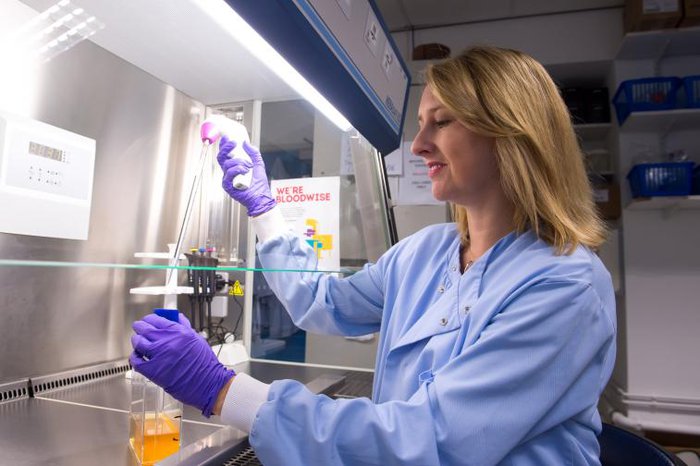How a virus can lead to lymphoma
Some types of lymphoma are associated with high levels of a small piece of genetic material called microRNA-155. Professor Michelle West has been investigating how a virus that causes lymphoma increases the production of this cancer-driving microRNA.
What links a common virus with lymphoma?
Chances are that at some point in your life you have been infected with the Epstein-Barr virus, or EBV, just like most of the world’s population. You are most likely to have been infected as a child, when symptoms tend to be mild and brief, if they’re there at all. If you’re less lucky, you will have been infected as a teenager, when sometimes it can cause glandular fever to develop.
EBV infects B cells (a type of white blood cell) and pushes them to divide indefinitely. Luckily for us, most of these virus-infected cells are recognised and destroyed by our immune system. A small number of infected cells do hide in our bodies, but usually do no long-term harm. However, if something happens to seriously reduce how well someone’s immune system works – like taking drugs that suppress your immune system after an organ transplant – these infected cells can grow in large numbers and give rise to lymphoma. Rarely, in people with healthy immune systems, changes in virus infected cells can also happen randomly (in ways we still don’t fully understand) and this can also lead to the appearance of lymphoma.
Know your enemy
Michelle West, Bloodwise-funded Professor of Tumour Virology at the University of Sussex, has been researching what changes happen in EBV infected B cells to drive lymphoma to develop. Some of Professor West’s most recent research looked at how EBV increases production of a small piece of genetic material called a microRNA. One microRNA she is interested in is called miR-155, which is known to be involved in many cancers, especially lymphomas.
“We’ve known since 1964 that EBV causes lymphoma but more work is still needed to understand how,” says Professor West. “We’ve been studying what changes the virus makes to infected B cells and how this happens. It’s only when we have this information that we can try to stop these changes happening or even try to reverse them. You have to know your enemy before you can defeat it!”
MicroRNAs control the levels of proteins in the cell by blocking them from being produced. There are hundreds of microRNAs in our cells that each affect the production of dozens of proteins. They function a bit like spanners that are used to fine-tune the running of an engine. Some microRNAs are overproduced in cancer cells and drive cancer cells to divide by preventing the production of proteins that can stop or slow growth – as though the engine is running too fast.
MiR-155 is produced in healthy B cells but is found at high levels in several different lymphomas. EBV-infected B cells produce much more miR-155 than normal B cells. The virus seems to use miR-155 to push infected B cells to divide, but how?
A new way to treat lymphoma?
EBV produces a small number of virus proteins in the cell. One of these, EBNA2, increases miR-155 production, but until now, no-one knew how it did so. Professor West’s team showed that EBNA2 switches on miR-155 by ‘docking’ at a region of DNA called an enhancer region. Enhancer regions work as control centres that can increase the likelihood of certain proteins being made elsewhere in the DNA. They also found a second route that EBNA2 uses to increase miR-155 production. This route is indirect and works by switching on production of a cell protein called IRF4, which in turn switches on mir-155 production.
Since high levels of miR-155 are seen in so many cancers, and its presence is known to be involved in resistance to treatment, it is an exciting potential target for anti-cancer drugs. Promising results are already being seen in the early stages of a clinical trial using an anti-miR-155 drug to treat cutaneous T cell lymphoma, and research is underway for an anti-miR-155 drug that could soon be tested in acute myeloid leukaemia.
Professor West is optimistic about the future of anti-miR-155 drugs as a potential treatment for lymphomas: “Uncovering how EBV switches on miR-155 provides support for the potential use of anti-miR-155 drugs for the treatment of EBV-associated lymphoma. Drugs that work by blocking the function of gene enhancers are also being investigated so this may also be a future possibility.”
How you can help us beat blood cancer
Professor West’s work and all the other exciting research we fund can only happen thanks to your support. Donate now, or find out more about fundraising.

